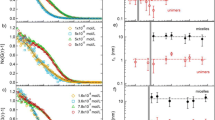Summary
The domain structures of film specimens cast from benzene solutions of a series of graft copolymer of poly(methyl acrylate) with styrene with different degrees of grafting, from 10 to 80 vol% of styrene component, were investigated with phase-contrast and dye-staining microscopy. The graft copolymers were synthesized by coupling polystyryllithium, obtained by anionic polymerization technique, onto a well-fractionated PMA, so that the coupling density of the grafted segment along the backbone segment was varied but the molecular weights of the grafted and backbone segments were kept constant to cover the above range of volume fraction of styrene component for the series of graft copolymer.
It was found that with an increase of the volume fraction of styrene component (grafted segment) the domain structure changes from spheres of styrene component dispersed in a matrix of MA component, to alternating lamellae of the two components, and to spheres of MA component dispersed in a matrix of styrene component. Two types of rodlike domains, usually found for block copolymers as the intermediates between the spherical and lamellar domains, were missed.
The domain formation mechanism was discussed in terms of a quasi-equilibrium phenomenon of micelle formation, microphase separation between the grafted and backbone segments, at a critical micelle concentration. TheGibbs free energies of five types of micelle formations; anA sphere in aB shell micelle, anA rod in aB sheath micelle, alternating lamellar micelle ofA andB, aB rod in anA sheath, and aB sphere in anA shell micelle, were discussed in terms of molecular and thermodynamic parameters. Comparing the free energy levels of the five types of micelle formations with each other, it was revealed that the free energy levels for forming the two types of rodlike micelles can not be the lowest at any volume fraction of grafted segment.
Similar content being viewed by others
References
Merrett, F. M., Trans. Faraday Soc.50, 759 (1954).
Merrett, F. M., Ric. Sci.25, 279 (1955).
Molau, G. E., Block Polymer, Arrarwal ed., pp. 79–106 (New York 1970).
Y. Gallot, M. Leng, H. Benoit, andP. Rempp, J. Chim. Phys.59, 1093 (1962).
Gallot, Y., E. Franta, P. Rempp, andH. Benoit, J. Polymer Sci., Part C4, 473 (1963).
Dondos, A., P. Rempp, andH. Benoit, J. Chim. Phys.62, 821 (1965).
Dondos, A., P. Rempp, andH. Benoit, J. Polymer Sci., Part B4, 293 (1966).
Merrett, F. M., J. Polymer Sci.24, 467 (1957).
Soen, T., T. Horino, Y. Ogawa, andH. Kawai, J. Appl. Polymer Sci.10, 1499 (1966).
Molau, G. E., J. Polymer Sci., Part A3, 1267 (1965).
Molau, G. E., J. Polymer Sci., Part A3, 4235 (1965).
Molau, G. E. andH. Keskkula, J. Polymer Sci., A-14, 1595 (1966).
Kato, K., Japan Plastics19, No. 10, 89 (1968).
Bucknall, C. B., Brit. Plastics40, 118 (1967).
Moton, M., A. A. Rembaum, andJ. L. Hall, J. Polymer Sci., Part A1, 361 (1963).
Moton, M. andR. Milkvich, J. Polymer Sci., Part A1, 443 (1963).
Moton, M., E. E. Bostick, andR. G. Clarke, J. Polymer Sci., Part A1, 475 (1963).
Basu, S. andH. Roy, J. Sci. Ind. Res.11B, 90 (1952).
Krigbaum, W. R. andP. J. Flory, J. Polymer Sci.11, 37 (1953).
Vanzo, E., J. Polymer Sci., Part A-14, 1727 (1966).
Inoue, T., T. Soen, H. Kawai, M. Fukatsu, andM. Kurata, J. Polymer Sci., Part B6, 75 (1968).
Inoue, T., T. Soen, T. Hashimoto, andH. Kawai, J. Polymer Sci., Part A-27, 1283 (1969).
Uchida, T., T. Soen, T. Inoue, andH. Kawai, J. Polymer Sci., Part A-2 (in press).
Soen, T., T. Inoue, K. Miyoshi, andH. Kawai, submitted to J. Polymer Sci., A-2.
Inoue, T., T. Soen, T. Hashimoto, andH. Kawai, Macromolecules3, 87 (1970).
Author information
Authors and Affiliations
Additional information
Dedicated to Prof.R. Hosemann on the occasion of his 60th birthday.
A part of M. S. thesis ofT. Ono, presented to the Department of Polymer Chemistry, Faculty of Engineering, Kyoto University, March 11, 1969; presented before the 18th Annual Meeting of the Society of Polymer Science, Japan, Kyoto, May 20, 1969.
Rights and permissions
About this article
Cite this article
Ono, T., Minamiguchi, H., Soen, T. et al. Domain structure and viscoelastic properties of graft copolymer. Kolloid-Z.u.Z.Polymere 250, 394–403 (1972). https://doi.org/10.1007/BF01507504
Received:
Issue Date:
DOI: https://doi.org/10.1007/BF01507504




